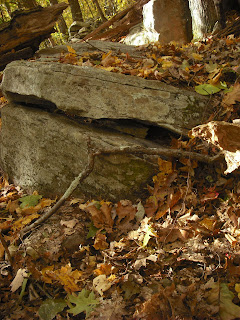In Seekonk, MA, is an old farm that is now a wildlife refuge. One of the trail destinations is a huge standing slab known as Monument Rock. It appears to be a huge manitou, about 7 feet tall, 4 feet across, and a foot thick. There is a wall in the background of the photo.
The view from the other side shows graffiti, and the wall to the left.
There is a a pile of stones next to the wall.
These may have been quarried from a huge boulder, leaving behind the manitou. The face of the manitou in sunlight above looks like slabs were pried off. Their flat faces would suit them for stacking into a wall. It is interesting that even if the stone was quarried to build a wall, a distinct manitou shape is left. A few feet away from the manitou is this split wedge boulder, also created by quarrying. The rock pile is visible in the background.
On the same property, huge quarried slabs form a bridge over a brook.
This site also has many well made walls. A few years ago, WSBE-36 (the RI PBS station) showed a special entitled Stories in Stone, about how the Narragansetts built many of the walls in RI. I recognized the bridge and a long curved wall in the special. One of the points made by the tribal historian is that the Narragansetts did not build walls until the white man came. In the context of the special, he meant these tall farm walls, and not the lower, looser stone rows that may be from ground clearing. The Indians who broke up boulders to build walls adapted their native techniques and left some distinctive stone structures.
*****************************************************************************
There is a very interesting article about Roger Williams at this page at Slate today.






At some point a look at professional soils might be useful in discerning more recent activities around walls. There are tools that can 'read' some below ground data, but haven't seen them used for this purpose. There are definitely wall to nowhere that were reused as property bounds - in whole or in part. Also, have found that some old walls are 'in balance' with an equinox lineup even as they go over hills and through depressions that might have caused someone with another purpose to go around these natural features.
ReplyDelete